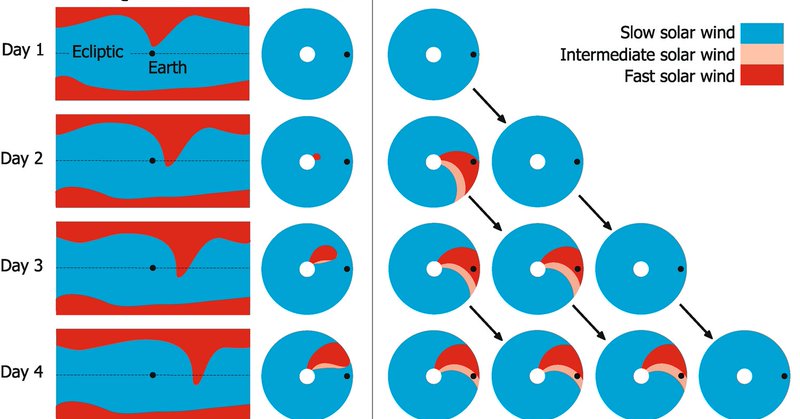
@mathewjowens.bsky.social
@mathewjowens
Followers
6K
Following
13K
Media
659
Statuses
8K
No longer posting here. Find me at https://t.co/tDuuyhYnwy
Reading, UK
Joined May 2010
I didn't see the point of announcing that I was no longer posting on X/twitter. But this encapsulates exactly why I've done so, and so much better than I could articulate. (Though, in fairness, George has access to a much bigger word count than me.) Hwyl!
This is my farewell post. I am not deleting this account, as I don’t want to lose the archive, and I don’t want my name taken by imposters. But, for as long as Musk owns the platform, I’ll no longer use it. I’m now posting at https://t.co/Ks8LIz0Qmt. Since Elon Musk bought this
0
0
3
New paper out on time-dependent solar wind modelling, and why it's definitely the way to go. https://t.co/EKvCHotZCw Head over here for a summary of the key points: https://t.co/roFqnBQBXP
nature.com
Scientific Reports - The importance of boundary evolution for solar-wind modelling
3
9
30
From CME arrival past predicted time to major geomagnetic storms, space weather forecasts can be both exciting and frustrating for aurora chasers. Join Space Weather Unplugged on Tuesday, November 19th, to learn about space weather forecasting forecasting with @mathewjowens
3
13
54
I wholeheartedly agree. Cutting U.K. R&D funding in today’s highly competitive and indeed dangerous world would be nothing short of idiotic.
As Chair of All Party Parliamentary & Scientific Committee, & former Minister for Science, Research & Innovation I have written to @RachelReevesMP to stress importance of R&D in growing the economy & tackling the big challenges we face... @sciencecampaign
https://t.co/vPtoJRdwWI
51
260
1K
Wow! Double trouble! ☀️🌬️ HUXt successfully modeled the impact of this morning's X3.3 CME and is forecasting the X1.8 CME to arrive 10-28 8:00 UT. Confidence is only ~50%, though, and uncertainties are relatively high (-6/+10 hr). Learn about HUXt here: https://t.co/NPgNf4DfkC
0
11
88
@L_A_Barnard But just to be clear, I still don't think this will do much at Earth, if/when it arrives.
1
0
4
Curious. @L_A_Barnard just alerted me that the Met Office have updated their CME estimate to also make it a glancing blow, arriving later today. We really need to find a way to start including event-specifoc uncertainties on CME parameters.
2
0
8
I'd somehow introduced a really intermittent and hard-to-pin-down bug into our HUXt solar wind model. It's taken 300,000 model runs to track it down and squash it. Fortunately, that's only a couple of hours computation. I don't know how people with "real" models cope!
1
0
12
I'd love to hear from anyone that actually does geometric (cone) model fitting to coronagraph observations about why the forecasts have estimated this halo CME to be non-Earth directed (or at best a very glancing blow)? It seems to clearly have an Earth-directed component to me.
2
3
27
Really proud of this work (my first time being fully responsible), where I show how the repeated emergence of solar active regions near one another can significantly inhibit the evolution of the coronal magnetic field. (1/3) Check it out here: https://t.co/OR0aoerfIA
3
20
71
Using the CME *shock* tracked by M2M in the DONKI database does give a glancing blow at Earth. This event really highlights the difficultly in determining the speed and direction when coronagraphs are near the Earth-Sun line.
4
32
137
The 6am run using the latest Met Office observer estimates has the fast partial halo CME directed well away from the Earth-Sun line. Not sure I understand that. But I'll put my faith in them and call this event a miss. Unless you're Venus. In which case, it's a-coming for you!
0
3
5
HUXt runs with CME estimates from DONKI (shown below) and the Met Office forecasters ( https://t.co/DTNh5POCYN) have this morning's partial halo CME as not being Earth directed. We'll see if that changes as more data becomes available.
3
4
38
Sorry to announce that after another @ERC_Research "so-very-close-but-no" funding outcome, I'm quitting space physics to fully devote myself to my role as unofficial @geocafeUK taste tester. Strong recommend for the new bean pastry. I'll be fat, poor and happy.
4
1
27
@eelcodoornbos Yeah, comparing the ground-based aurora sightings with the combined vis/IR auroral obs from space suggests the aurora was observed a very long way from overhead:
3
5
28
The aurora on May 11, 2024, was the third most extensive aurora seen on record. It was seen down to Ad Dakhiliyah, Oman, which sits at a geomagnetic latitude of 18.08° N. This would also mean this was the most extensive aurora on record since February 1872.
5
12
86
A fascinating paper - extra interesting for someone looking in from history POV is how many of early readings are from colonial/military sources. I also know many archaeologists in last few months will have been looking at the skies wondering what folks thought way back when...
Auroral *occurrence* over the last 375 years has changed as a result of the Earth's magnetic field and solar activity. But auroral *reporting* has a human element; it requires occurrence overlapping with population. And very recently, tech. https://t.co/D7VFo5DJcf
3
5
22
One of the most interesting findings is a null result. While very low-latitude aurora do correlate with strong geomagnetic storms, there's almost no correlation with the size of the sunspot from which the storm originates. Don't underestimate the little ones.
1
3
31
Auroral *occurrence* over the last 375 years has changed as a result of the Earth's magnetic field and solar activity. But auroral *reporting* has a human element; it requires occurrence overlapping with population. And very recently, tech. https://t.co/D7VFo5DJcf
6
31
133











